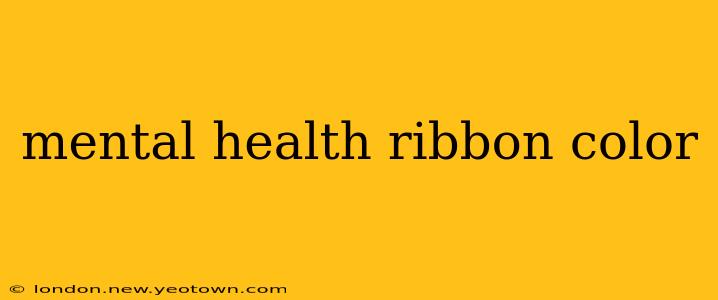The Meaning Behind the Colors: A Journey Through Mental Health Awareness Ribbons
The sight of a ribbon, often pinned to lapels or waved proudly at events, instantly conveys a message of support and solidarity. But have you ever paused to consider the significance of the color choices behind these symbols of awareness? For mental health, the color choice isn't a single, universal hue, but a vibrant tapestry reflecting the complexities and nuances of mental well-being. Let's unravel the story behind these important ribbons and what they represent.
While there isn't one officially designated color for all mental health conditions, the color green has emerged as a prominent and widely recognized symbol. This association likely stems from its association with growth, healing, and nature – qualities that resonate deeply with the journey toward mental wellness. Seeing a green ribbon often signifies a commitment to supporting individuals and organizations working to improve mental health resources and reduce stigma.
However, different organizations and campaigns may choose different colors to represent specific mental health issues or causes. This is a crucial point to understand: context matters greatly when interpreting the meaning of a mental health ribbon.
What are the different colors used for mental health awareness?
This is a question that often sparks curiosity. The truth is, there’s not a rigid color code for every mental illness. Many organizations choose colors that best represent their specific mission or resonate with the feelings associated with the condition they champion. This can lead to a wide variety of ribbon colors being used within the larger mental health awareness movement. For example, while green is frequently seen, you might also encounter ribbons in other shades for particular causes, adding complexity to the landscape of mental health awareness.
What color ribbon is for mental health awareness month?
There isn't a single official color designated specifically for Mental Health Awareness Month (typically observed in May in the United States). The emphasis during this month is on raising broader awareness about mental health issues in general, promoting education, and reducing stigma. Therefore, you'll likely see a range of colors used during this time, reflecting the diverse nature of mental health conditions. Many organizations utilize the color green, but other colors tied to specific causes might also be present.
Is there a specific color for each mental illness?
No, there isn't a universally recognized, specific color for each individual mental illness. The use of color in awareness ribbons is often driven by the individual organizations themselves and can vary significantly. This lack of standardization can sometimes be confusing, but it highlights the importance of understanding the context in which a ribbon is presented. Always seek further information about an organization's mission if you encounter a less familiar color choice.
What does a yellow ribbon represent in mental health?
A yellow ribbon, while not as frequently associated with mental health as green, might be used by some organizations to signify specific causes or campaigns relating to mental wellness. Again, context is vital. The meaning would be determined by the specific organization or campaign utilizing the ribbon, not a universally accepted designation.
The world of mental health awareness ribbons isn't about strict adherence to a predefined color code. Instead, it’s a vibrant and evolving tapestry of colors, each carrying its own potential message of support and understanding. The most important takeaway is the collective effort to reduce stigma and promote mental wellbeing. The color of the ribbon, while visually important, is secondary to the underlying message of compassion and support.

